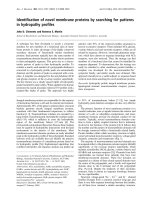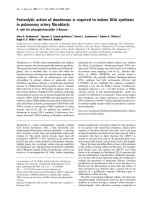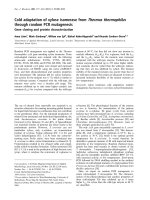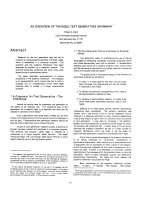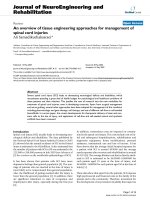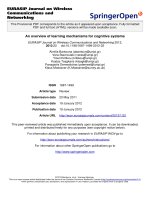Báo cáo y học: " An overview of treatment response rates to various anti-viral drugs in Pakistani Hepatitis B Virus infected patients" doc
Bạn đang xem bản rút gọn của tài liệu. Xem và tải ngay bản đầy đủ của tài liệu tại đây (217.41 KB, 4 trang )
REVIEW Open Access
An overview of treatment response rates to
various anti-viral drugs in Pakistani Hepatitis
B Virus infected patients
Liaqat Ali
*
, Muhammad Idrees
*
, Muhammad Ali, Irshad-ur Rehman, Abrar Hussain, Samia Afzal, Sadia Butt,
Sana Saleem, Saira Munir, Sadaf Badar
Abstract
Hepatitis B virus (HBV) is one of the leading health problem with up to 350 million affected people worldwide
including 4.5 million only in Pakistan. It has mortality rate of 0.5 to 1.2 million per year worldwide. Pakistan lies in
the endemic region with 3-5% HBV carrier rate in the country. The present article reviews the literature on the
treatment response of HBV prevalent in Pakistani population. The average treatment response of Lamivudine and
interferon-a is 25.81% and 47.95%, respectively. Peg-Interferon was shown to be not effective against the HBV/HCV
(hepatitis C virus)/HDV (hepatitis Delta virus) co-infection. The present study reveals that interferon-a is the most
effective therapy available for HBV infection prevalent in Pakistani population. Genotype C & D are the most
common HBV genotypes in Pakistan and are associated with increased severity and less response to interferon
therapy. This poses a great challenge for physicians and researchers and further studies are needed to describe the
outcome of the current therapies recommended against HBV infection in Pakistani population.
Introduction
Hepatitis B virus (HBV) is a crucial health problem with
up to 350 million affected people worldwide [1]. HBV is
amemberoftheHepadnaviridae family with 3.2 kilo-
base pair DNA genome which is partially double-
stranded [2,3]. Pre-s domain surface protein is mediates
its attachment to the cell membrane [4].
Several previous studies on the association of the HBV
genotypes with disease progression reported that geno-
types B and C are correlated with severity of liver dys-
function while high viral loads were observed in patients
infected with genotype C [5,6], A, and D [7] in some
studies but not in others [8,9]. According to WHO,
Pakistan has low HBV i nfection rates of 3%, while stu-
dies from Pakistan are more focused towards the HBV
prevalence rate [10,11], epidemiological issues [12], gen-
otyping and its core antigen genetic variability [13].
Approved drugs advised for the treatment of HBV
include interferon-a, PEG- interferon and antiviral drugs
like lamivuaine, adefovir, dipivoxil, entecavir and telbivu-
dine. Hepatitis B antibodies and the HBV vaccine within
12 hours of birth help to prevent the infection [14]. In
Pakistan, there are estimated 4.5 million carriers of HBV
with a ca rrier rate of 3-5%. However, studies are limited
describing HBV treatment response in Pakistani popula-
tion. The present article reviews all the available litera-
ture on the treatment response to the available therapies
against HBV prevalent in Pakistani population (Table 1).
Anti viral efficacy of lamivudine
A nucleoside analogue called lamivudine, has anti- HBV
and anti-HIV properties, was approved by the US-FDA
in 1998 for the treatment of HBV infectio ns. It is admi-
nistered orally with concentration of 100 mg/day [15].
Use of lamivudine is reported to decrease the circulating
DNA levels of HBV [16,17] while long term decrease
has been achieved after one month’s therapy [18]. In
Pakistani population, the rate of seroconversion against
lamivudine was observed to be 16% in HBV/HDV(Hepa-
titis delta Virus) co-infected patients when administered
for 36 months [19], 23 to 38% in HBV infe cted patients
when administer ed for 12 months and 36 months,
* Correspondence: ;
Division of Molecular Virology, National Centre of Excellence in Molecular
Biology, University of the Punjab, 87 - West Canal Bank Road, Thoker Niaz
Baig, Lahore 53700, Pakistan
Ali et al. Virology Journal 2011, 8:20
/>© 2011 Ali et al; licensee BioMed Central Ltd. This is an Open Access article distributed under the terms of the Creative Commons
Attribution License ( whi ch permits unrestricted use, distribution, and reproduction in
any medium, provid ed the original work is properly cited.
respectively (Table 1) [20,21]. A much higher HBV
response rate is being observed in Pakistani population
than reported earlier [22]. These studies show that lami-
vudine monotherapy is a better option for treatment of
HBV infection but this therapy require longer durations
(up to 36 months) and develop increased resistance (up
to 20% after one year and 70% after 5 years of therapy)
[23,24], which makes it undesirable for the patients.
Nucleotide and nucleoside analogues are shown to be
associated with minimum side effects as compared to
the standard INF and PEG-INF therapies. These i nclude
short term adversed effects like myopathy, neuropathy
and lactic acidosis [25]. These include side effects like
abdominal pain, headache, cou gh, nasopharyngitis, pyr-
exia, diarrhea and fatigue [26].
Anti viral efficacy of Peg-Interferon
Interferon is supplemented with polyethylene glycol
(PEG) which prolongs its half-li fe resulting in sustained
antiviral response rates. Two types of PEG-IFN have
been studied for HBV therapy, PEG-IFN a-2a having
a large 40 kDa PEG branched and PEG-IFN a-2b with
a 12 kDa PEG molecule [27]. Buster and Janssen [22]
reported HBV treatment response of 19-35% by admin-
istration of peg-IFN. However, administration of pegy-
lated interferon-a 2a for 4 months failed to treat the
HBV, HDV and HCV co-infection in Pakistani popula-
tion [20] and is associated with adverse effects like
depression, flu-like symptoms, neuropsychiatric disor-
ders and suppression of bone marrow [28].
Thi s shows that peg-interferon is not effective agai nst
HBV when administered in HBV/HDV/HCV co-infected
patients. However, there is no study describing the use
of peg-interferon against HBV infected Pakistani
population.
Anti viral efficacy of Interferon-a (IFN-a)
IFN-a was approved in 1992 after being extensively stu-
died. It is reported to increase hepatitis B surface anti-
gen (HBsAg) expression by hepatocytes and inhibit
packaging of pre-gen omic viral RNA into the core parti-
cles [29]. Currently, many different types of interferon
are available but available data is limited to support
advantage of one therapy to be more effective than the
others. However, the response rate of 30-40% was
reported by the administration of IFN- a fo r 6-12
months as compared to 10-20% in controls. Patients
with lower ALT and/or higher HBV viral loads and
immunosuppressed patients are the risk factors that
result in decreased response to IFN treatment. Hepatitic
flares are shown to predict sustained virological
response during interferon treatment [30]. Naeem and
coworkers [31] reported that administration of 5MIU of
recombinant IFN-a-2b for four mont hs lead to response
in 44% of Pakistani patients. On the other hand, Zuberi
and colleagues [32] described an increased treatment
response of 51.9% after administration of 10.0 MIU of
IFN-a in HBV infected patients for the same period of
16 weeks. IFN-a is also shown to be associat ed with the
development of side effects like insomnia, fatigue,
Table 1 An overview of treatment outcome in Pakistani HBV treated patients
Author Region Patients
(n)
Etiology Treatment Duration (weeks) Results
Qureshi
et al: [19]
Karachi 69 HBeAg, HBV DNA
positive patients
100 mg of
Lamivudine orally
before breakfast till
seroconversion
36 months 38% cases were observed to sero-
converted.
Qureshi
et al: [19]
Karachi 55 HBV DNA positive
(wild type) with
delta positive
100 mg of
Lamivudine orally
before breakfast till
seroconversion
36 months 16.4% cases in group 2 sero-converted
(Wild type of HBV/HDV co-infected cases
have a 16% chance of seroconversion)
Naeem
et al: [31]
Rawalpindi 50 Chronic viral
hepatitis B (HBsAg
and HBV DNA
positive)
5 mega units of
recombinant
interferon alfa-2b
subcutaneously once
daily
4-months HBV DNA was found negative in 44.0% (22)
patients while treatment was ceased in
three patients due to severe depression.
Zuberi
et al: [21]
Karachi 246 co/super-infection
of Hepatitis C and
D among patients
of HBV
pegylated interferon-
a 2a 180 mcg sc
weekly
48 weeks HBV was not cleared in any case
Zuberi
et al: [32]
Karachi 52 patients of
hepatitis B with
hepatitis D
Interferon - a 10.0
MIU sc t.i.w.
48 weeks 51.9% patients had suppressed (< 400
copies/ml) HBV DNA levels
Khokhar
et al. [21]
Islamabad 105 positive HBsAg
and elevated ALT
lamivudine 100 mg
once a day for 12
months
12 months and were
followed every 2-3
months with ALT,
HBeAg and HBV DNA
HBeAg positive and HBeAg negative
patients were found with 23.6% and 80.0%
treatment response rate respectively (All
the patients were HBsAg positive)
Ali et al. Virology Journal 2011, 8:20
/>Page 2 of 4
alopecia and anorexia [33,34]. However, further studies
on the treatment response and follow up of patients are
need ed to understand the effectiveness of IN F-a against
HBV infection in Pakistani population.
HBV genetic heterogeneity and Antiviral Therapy
HBV has been classified into 9 genotypes (A-I) based on
8% or more inter-group divergence in full length geno-
mic sequence [35-38] and its antiviral treatment
response rate is highly affected by genetic variability as
well as by various host and viral factors.
The most recent study conducted throughout Pakistan
has reported that HBV genotype C is the most preva-
lent genotype in Pakistan with 26.7% prevalence, fol-
lowed by genotype B (18%), A (14.3%), D (13%), mixed
genotypes (14.6%) and 10.3% were found untypable [38].
While genotypes E (0.6%) and F (1.3%) have been
reported recently in Pakistan. A very high prevalen ce of
HBV genotype D (60-100%) were also reported from
different regions of Pakistan [39-44,13]. It is well under-
stood that both genotype C & D are less responsive to
interferon therapy and associated with more severe dis-
ease than genotype A and B [45,46]. Moreover, these
genotypes are reported to be less frequently related to
HBeAg clearance rates than genotypes A and B when
treated with pegylated interferon [47]. Another study
revealed that antiviral response rate against IFN-alpha
was higher in genotype F as compared to genotypes E
and G [48].
The high prevalence of HBV genotype D and C in
Pakistani population and its association with increased
severityofthediseaseandresistance to the present
therapies demands more consistent preventive measures
like mass vaccinati on and awarene ss programs at
national level.
Conclusion
This review explains that interferon-a is the most effec-
tive available drug against the HBV prevalent in Pakistan
with up to 47.95% treatment response rate. Moreover,
treatment of the resistant but most prevalent HBV gen-
otypes C and D is a challe nge for clinicians and s cien-
tists in our region. However, further studies are needed
to fully describe the treatment response and the risk fac-
tors of the currently recommended therapies against
HBV infecti on especially combination therapy of inter-
feron and lamivudine in Pakistani isolates. These future
prospects will enable the virologists to focus drug
designing in this part of the world.
Authors’ contributions
LA and MA reviewed the literature, and wrote the manuscript. MI reviewed
the manuscript. IR, AH, SA, SB, SS, SM and SB helped LA & MA in literature
review. All the authors read and approved the final manuscript.
Competing interests
The authors declare that they have no competing interest s.
Received: 5 December 2010 Accepted: 15 January 2011
Published: 15 January 2011
References
1. Awan Z, Idrees M, Rafique S, Rehman I, Akbar H, But S, et al: Hepatitis B
virus YMDD-motif mutations with emergence of lamivudine-resistant
mutants: a threat to recovery. Gastroenterology and Hepatology From Bed
to Bench 2010, 3:108-114.
2. Lee W: Hepatitis B virus infection. N Engl J Med 1997, 337:1733-1745.
3. Ganem D, Schneiden RJ, et al: Hepadnaviridae: the viruses and their
replication. In Fields Virology. Edited by: Knipe DM, Howely PM, Griffin DE.
Philadelphia: Lippincott-Raven; 2001:292-2969.
4. Klingmuller U, Schallen H: Hepadnavirus infection requires interaction
between the viral pre-s domain and a specific hepatocellular receptor. J
Virol 1993, 67:7414-7422.
5. Sugauchi F, Chutaputti A, Orito E, Kato H, Suzuki S, Ueda R, Mizokami M:
Hepatitis B virus genotypes and clinical manifestation among hepatitis B
carriers in Thailand. J Gastroenterol Hepatol 2002, 17:671-676.
6. Ishikawa K, Koyama T, Masuda T: Prevalence of HBV genotypes in
asymptomatic carrier residents and their clinical characteristics during
long-term follow-up: the relevance to changes in the HBeAg/anti-HBe
system. Hepatol Res 2002, 24:1.
7. Westland C, Delaney W, Yang H, Gibbs C, Miller M, Wulfsohn MJ: Hepatitis
B virus genotypes and virologic response in 694 patients in phase III
studies of adefovir dipivoxil1. Gastroenterology 2003, 125:107-116.
8. Sumi H, Yokosuka O, Seki N, Arai M, Imazeki F, Kurihara T, Kanda T, Fukai K,
Kato M, Saisho H: Influence of hepatitis B virus genotypes on the
progression of chronic type B liver disease. Hepatology 2003, 37:19-26.
9. Orito E, Mizokami M, Sakugawa H, Michitaka K, Ishikawa K, Ichida T, et al:
A case-control study for clinical and molecular biological differences
between hepatitis B viruses of genotypes B and C. Japan HBV Genotype
Research Group. Hepatology 2001, 33:218-223.
10. Khichi GQK, Channar MS: Prevalence of hepatitis B carriers among
children in Bahawalpur urban slums. Pak J Med Sci 2000, 16:238-241.
11. Khattak MF, Salamat N, Bhatti FA, Qureshi TZ: Seroprevalence of hepatitis
B, C and HIV in blood donors in northern Pakistan. J Pak Med Assoc 2002,
52:398-402.
12. Akhtar S, Younus M, Adil S, Hassan F, Jafri SH: Epidemiologic study of
chronic hepatitis B virus infection in male volunteer blood donors in
Karachi, Pakistan. BMC Gastroenterol 2005, 5:26.
13. Abbas Z, Muzaffar R, Siddiqui A, Naqvi SAA, Rizvi SAH: Genetic variability in
the precore and core promoter regions of hepatitis B virus strains in
Karachi. BMC Gastroenterol 2006, 6:20.
14. Gilroy RK, Mukherjee S:
Hepatitis A. Kanas
Med Centre 2008.
15. Cammack N, Rouse P, Marr CL, Reid PJ, Boehme RE, Coates JA, Penn CR,
Cameron JM: Cellular metabolism of (-) enantiomeric 2’-deoxy-3’-
thiacytidine. Biochem Pharmacol 1992, 43:2059-2064.
16. Dienstag JL, Schiff ER, Wright TL, Perrillo RP, Hann HW, Goodman Z, et al:
Lamivudine as initial treatment for chronic hepatitis B in the United
States. N Engl J Med 1999, 341:1256-1263.
17. Lai CL, Chine RW, Leung NWY, Chang TT, Guan R, Tai DI, et al: A one year
trial of lamivudine for chronic hepatitis B. N Engl J Med 1998, 339:61-68.
18. Yuen MF, Fong DY, Wong DK, Yuen JC, Fung J, Lai CL: Hepatitis B virus
DNA levels at week 4 of lamivudine treatment predict the 5-year ideal
response. Hepatology 2007, 46:1695-1703.
19. Qureshi H, Arif A, Alam E: Treatment of HBV and HDV co-infection using
lamivudine. J Ayub Med Coll Abbottabad 2009, 21:1-3.
20. Zuberi BF, Afsar S, Quraishy MS: Triple Hepatitis: Frequency and
Treatment Outcome of co/super-Infection of Hepatitis C and D Among
Patients of Hepatitis B. J Coll Physicians Surg Pak 2008, 18:404-407.
21. Khokhar N, Gill ML, Alam AY: Treatment of chronic Hepatitis B with
Lamivudine. J Coll Physicians Surg Pak 2005, 15:78-80.
22. Buster EHCJ, Janssen HLA: Antiviral treatment for chronic hepatitis B virus
infection-immune modulation or viral suppression? The Journal of
Medicine 2006, 64:175-185.
23. Lok AS, Lai CL, Leung N, Yao GB, Cui ZY, Schiff ER, et al: Long-term safety
of lamivudine treatment in patients with chronic hepatitis B.
Gastroenterology 2003, 125:1714-1722.
Ali et al. Virology Journal 2011, 8:20
/>Page 3 of 4
24. Pawlotsky JM, Dusheiko G, Hatzakis A, Lau D, Lau G, Liang TJ, et al:
Virologic monitoring of hepatitis B virus therapy in clinical trials and
practice: recommendations for a standardized approach. Gastroenterology
2008, 134:405-415.
25. Sonneveld MJ, Janssen HLA: Pros and cons of peginterferon versus
nucleos(t)ide analogues for treatment of chronic hepatitis B. Curr
Hepatitis Rep 2010, 9:91-98.
26. Chang T, Gish RG, de-Man R, Gadano A, Sollano J, Chao Y, et al:
A Comparison of Entecavir and Lamivudine for HBeAg-Positive Chronic
Hepatitis B. N Engl J Med 2006, 354:1001-10.
27. Craxi A, Cooksley WG: Pegylated interferons for chronic hepatitis B.
Antiviral Res 2003, 60:87-89.
28. Chang T, Suh DJ: Current approaches for treating chronic hepatitis B:
when to start, what to start with, and when to stop. Hepatol Int 2008, 2:
S19-S27.
29. Lau JYN, Bain VG, Naomov NV, Smith HM, Alexander GJ, Williams R: Effect
of interferon-a on hepatits B viral antigen expression in primary
hepatocyte culture. Hepatology 1991, 14:9759.
30. Guan R: Interferon monotherapy in chronic hepatitis B. J Gastroenterol
Hepatol 2000, 15:34-40.
31. Naeem MA, Khan I, Waris J, Usman M: Efficacy of Interferon therapy in
patients of chronic hepatitis B viral infection treated at MH Rawalpindi.
Professional Med J 2008, 15:380-386.
32. Zuberi BF, Quraishy MS, Afsar S, Akhtar N, Kumar A, Dodani SK: Treatment
outcome in patients of hepatitis B with hepatitis D: Experience of
4 years at a tertiary care centre in Pakistan. J Coll Physicians Surg Pak
2007, 17:320-322.
33. Okushin H, Ohnishi T, Morii K, Uesaka K, Yuasa S: Short-term intravenous
interferon therapy for chronic hepatitis B. World J Gastroenterol 2008,
14:3038-3043.
34. Cooksley WG, Piratvisuth T, Lee SD, Mahachai V, Chao YC, Tanwandee T,
Chutaputti A, Chang WY, Zahm FE, Pluck N: Peginterferon alpha-2a (40
kDa): an advance in the treatment of hepatitis B e antigen-positive
chronic hepatitis B. J Viral Hepat 2003, 10:298-305.
35. Okamoto H, Tsuda F, Sakugawa H, Sastrosoewinjo RI, Imai M, Miyakawa Y,
Mayumi M: Typing hepatitis B virus by homology in nucleotide
sequence: comparison of surface antigen subtypes. J Gen Virol 1988,
69:2575-2583.
36. Huy T, Ngoc T, Abe K: New complex recombinant genotype of hepatitis
B virus identified in Vietnam. J Virol 2008, 82:5657-5663.
37. Yu H, Yuan Q, Ge SX, Wang HY, Zhang YL, Chen QR, Zhang J, Chen PJ,
Xia NS: Molecular and phylogenetic analyses suggest an additional.
Hepatitis B virus genotype
‘’I’’. PLoS One 2010, 5:9297.
38. Awan Z, Idrees M, Amin I, et al: Pattern and Molecular Epidemiology of
Hepatitis B virus genotypes circulating in Pakistan. Infect Genet Evol 2010,
10:1242-1246.
39. Ahmed CS, Wang ZH, Bin Z, Chen JJ, Kamal M, Hou JL: Hepatitis B virus
genotypes, subgenotypes, precore, and basal core promoter mutations
in the two largest provinces of Pakistan. J Gastroenterol Hepatol 2009,
24:569-73.
40. Baig S, Siddiqui A, Chakravarty R, Moatter T: Hepatitis B virus
subgenotypes D1 and D3 are prevalent in Pakistan. BMC Research Notes
2009, 2:1.
41. Noorali S, Hakim ST, McLean D, Kazmi SU, Bagasra O: Prevalence of
Hepatitis B virus genotype D in females in Karachi, Pakistan. J Infect
Developing Countries 2008, 2:373-378.
42. Hakim ST, Kazmi SU, Bagasra O: Seroprevalence of hepatitis B and C
genotypes among yung apparently healthy females of Karachi-Pakistan.
Libyan J Med 2008, 3:66-70, AOP: 071123.
43. Alam MM, Zaidi SZ, Shaukat S, Sharif S, Angez M, Naeem A, et al: Common
Genotypes of Hepatitis B virus prevalent in Injecting drug abusers
(addicts) of North West Frontier Province of Pakistan. Virology J 2007,
4:63.
44. Baig S, Siddiqui AA, Ahmed W, Qureshi H, Arif A: The association of
complex liver disorders with HBV genotypes prevalent in Pakistan.
Virology J 2007, 4:128.
45. Kao JH, Wu NH, Chen PJ, Lai MY, Chen DS: Hepatitis B genotypes and the
response to interferon therapy. J Hepatol 2000, 33:998-1002.
46. Wai CT, Chu CJ, Hussain M, Lok AS: HBV genotype B is associated with
better response to interferon therapy in HBeAg-positive chronic
hepatitis than genotype C. Hepatology 2002, 36:1425-30.
47. Janssen HLA, Senturk H, Zeuzem S, Akarka U, Cakalluglu Y, Simon K, et al:
Peginterferon alfa 2b and lamivudine combination therapy compared
withpeginterferon alfa 2b for chronic HBeAg positive hepatitis B:
randomized controlled trial in 307 patients. Hepatology 2003, 38:1323.
48. Erhardt A, Gobel T, Ludwig A: Response to antiviral treatment in patients
infected with hepatitis B virus genotypes E-H. J Med Virol 2009,
81:1716-1720.
doi:10.1186/1743-422X-8-20
Cite this article as: Ali et al.: An overview of treatment response rates to
various anti-viral drugs in Pakistani Hepatitis B Virus infected patients.
Virology Journal 2011 8:20.
Submit your next manuscript to BioMed Central
and take full advantage of:
• Convenient online submission
• Thorough peer review
• No space constraints or color figure charges
• Immediate publication on acceptance
• Inclusion in PubMed, CAS, Scopus and Google Scholar
• Research which is freely available for redistribution
Submit your manuscript at
www.biomedcentral.com/submit
Ali et al. Virology Journal 2011, 8:20
/>Page 4 of 4


